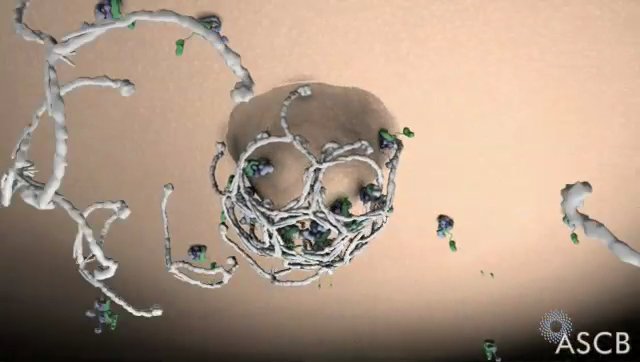Clathrin
Molecular biology is amazing, and clathrin is a fascinating example. It's a molecule with a very peculiar shape.
Here it is: (at the bottom of the image)
It has three legs with little feet, so it gets called a triskelion, like the symbol of the Isle of Man.
When lots of clathrin molecules get together they lock into each other, eventually constructing the polyhedral cage shown at the top of the image above. It's highly evolved, an exquisite piece of engineering: the shape of the clathrin is precisely specified by the genes that make it for a very specific purpose.
There are simpler ways of making balls and simpler ways of making polyhedra. But clathrin polyhedra can be made to assemble and then disassemble, depending on the chemicals around them. The cell uses clathrin for pulling on its own membrane, for example in the animation below where a cell is shown 'drinking' from its surrounding fluid by first making a dimple in its membrane and then digesting the resulting vesicle:
 (from http://student.ccbcmd.edu/~gkaiser/biot
(from http://student.ccbcmd.edu/~gkaiser/biot
A brilliant video, looking from the inside of the cell, shows how clathrin is used for this purpose, gripping onto the membrane with its little feet as the polyhedron assembles and pulling it into shape:
 (click for video)
(click for video)
This process is going on all the time, inside you right now.
Here are some electron micrograph images of clathrin in real life, showing the dimples coated in meshes of clathrin: [1]
Here it is: (at the bottom of the image)
It has three legs with little feet, so it gets called a triskelion, like the symbol of the Isle of Man.
When lots of clathrin molecules get together they lock into each other, eventually constructing the polyhedral cage shown at the top of the image above. It's highly evolved, an exquisite piece of engineering: the shape of the clathrin is precisely specified by the genes that make it for a very specific purpose.
There are simpler ways of making balls and simpler ways of making polyhedra. But clathrin polyhedra can be made to assemble and then disassemble, depending on the chemicals around them. The cell uses clathrin for pulling on its own membrane, for example in the animation below where a cell is shown 'drinking' from its surrounding fluid by first making a dimple in its membrane and then digesting the resulting vesicle:
 (from http://student.ccbcmd.edu/~gkaiser/biot
(from http://student.ccbcmd.edu/~gkaiser/biotA brilliant video, looking from the inside of the cell, shows how clathrin is used for this purpose, gripping onto the membrane with its little feet as the polyhedron assembles and pulling it into shape:
 (click for video)
(click for video)This process is going on all the time, inside you right now.
Here are some electron micrograph images of clathrin in real life, showing the dimples coated in meshes of clathrin: [1]
This post was originally on LiveJournal.
